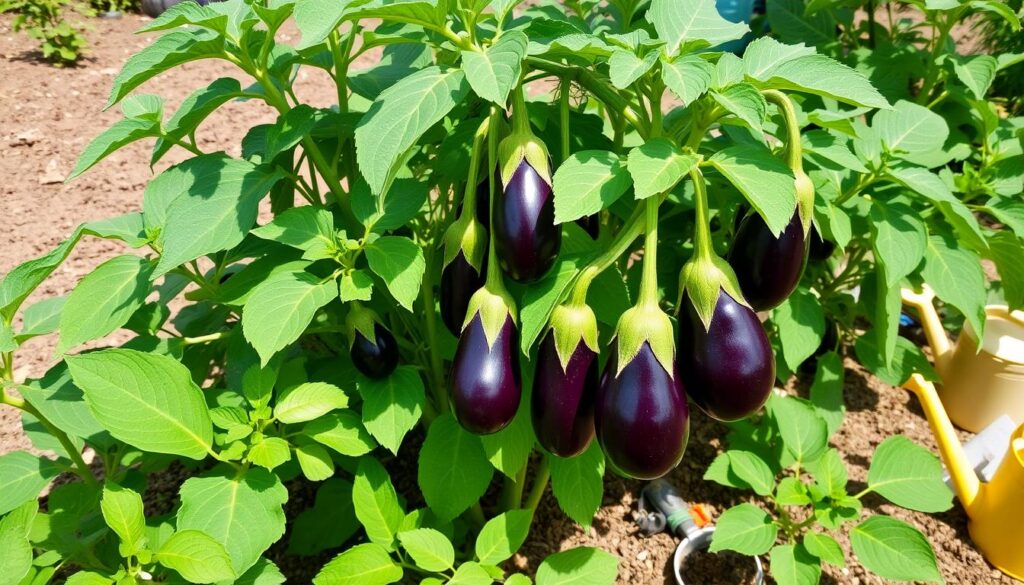Learning to grow eggplant can be very rewarding. With the right tips, you can have a big harvest. First, you need to know the basics of growing eggplant. This includes the different types and what they need to grow.
For more on growing plants in containers, check out a beginner’s guide to gardening in containers.
Mastering eggplant growing takes patience and the right techniques. It’s fun and rewarding, whether you’re new or experienced. With the right tips, you can grow tasty and healthy eggplants at home.
Introduction to Eggplant Growing
Growing eggplant is easy once you know the basics. With the right steps and techniques, you can grow eggplants like a pro. This way, you’ll enjoy a successful harvest.
Key Takeaways
- Learn the basics of eggplant growing, including the different varieties and their growing requirements.
- Understand the importance of providing the right conditions for eggplant growth, including sunlight, water, and nutrients.
- Follow the right techniques for planting, caring for, and harvesting eggplants.
- Use the right tools and materials to support eggplant growth and prevent common problems.
- Be patient and dedicated to the process of growing eggplants, as it can take time and effort to achieve success.
- Stay informed about the best eggplant growing tips and techniques to ensure a successful harvest.
Understanding Eggplant Varieties and Their Growing Requirements
When growing eggplants, knowing the different types and their needs is key. The right Eggplant Care Instructions help you pick the best for your garden. It’s important to think about the climate and temperature each variety needs.
A good Eggplant Planting Guide gives you the info to choose wisely. Home garden favorites include Black Beauty, Fairy Eggplant, and Rosa Bianca. Each has its own special traits and growing needs.
Popular Eggplant Varieties for Home Gardens
- Black Beauty: known for its deep purple color and high yield
- Fairy Eggplant: a compact variety perfect for small gardens
- Rosa Bianca: an Italian variety with a delicate flavor and pale purple color
Climate and Temperature Requirements
Eggplants love warm weather, best between 65-75°F (18-24°C). They need lots of sun and soil that drains well. By following the right Eggplant Care Instructions and using a good Eggplant Planting Guide, you’ll get a great harvest.
| Variety | Temperature Requirement | Climate |
|---|---|---|
| Black Beauty | 65-75°F (18-24°C) | Full sun |
| Fairy Eggplant | 60-70°F (15-21°C) | Partial shade |
| Rosa Bianca | 65-75°F (18-24°C) | Full sun |
Essential Tools and Materials for Growing Eggplant
To grow eggplants well, you need the right tools and materials. The Best Soil for Eggplant is key. It should be well-balanced and have the right pH. The best soil is rich in organic matter and has a pH of 6.0 to 6.5.
Here are some tools and materials you’ll need:
- Containers with good drainage
- Fertilizers high in phosphorus
- Pruning equipment, such as gardening shears and clippers
- Mulch to retain moisture and suppress weeds
Choosing the right eggplant variety is also important. With the right Best Soil for Eggplant and care, you’ll have a great harvest.
Investing in the right tools and materials gives your eggplants a great start. It helps them grow healthy and strong. Whether you’re new to gardening or experienced, the right equipment and knowledge are essential.
Selecting the Best Location for Your Eggplant Garden
Choosing the right spot for your Eggplant Plant Care is key to a great harvest. The spot you pick can really affect how well your eggplants grow. Think about a few important things to make sure your eggplants get what they need.
One important thing for Eggplant Plant Care is sunlight. Eggplants need lots of sun to grow well. Pick a spot that gets direct sunlight for at least 6 hours a day.
Sunlight Requirements
Space is also important for your eggplants. They need room to grow big. Make sure your garden bed is big enough for the plants when they’re fully grown.
Space Considerations
Wind protection is another big part of Eggplant Plant Care. Eggplants can get hurt by strong winds. Find a spot that keeps them safe from wind. You can also use row covers or other things to block the wind.
Wind Protection Tips
Here are some tips for keeping your eggplants safe from wind:
- Plant them in a spot where wind can’t get to them, like behind a fence or wall.
- Use row covers or other windbreaks to keep them safe.
- Plant them in a place with good air flow to stop diseases.
By thinking about these things and following good Eggplant Plant Care tips, you can make a great spot for your eggplants to grow.
| Factor | Consideration |
|---|---|
| Sunlight | Full sun for at least 6 hours a day |
| Space | Adequate space for mature plant size |
| Wind Protection | Protection from strong winds using row covers or windbreaks |
How to Grow Eggplant from Seeds
Growing eggplants from seeds can be very rewarding. With the right Eggplant Growing Tips, you can succeed. First, pick high-quality seeds that fit your climate and the eggplant type you want.
Then, plant the seeds in a seed tray or small pots with a good seed mix. Make sure the soil is warm and moist. Also, give the seeds enough light to grow. When the seedlings have 2-3 sets of leaves, move them to bigger pots or directly into the garden. Follow the Eggplant Growing Tips for spacing and care.
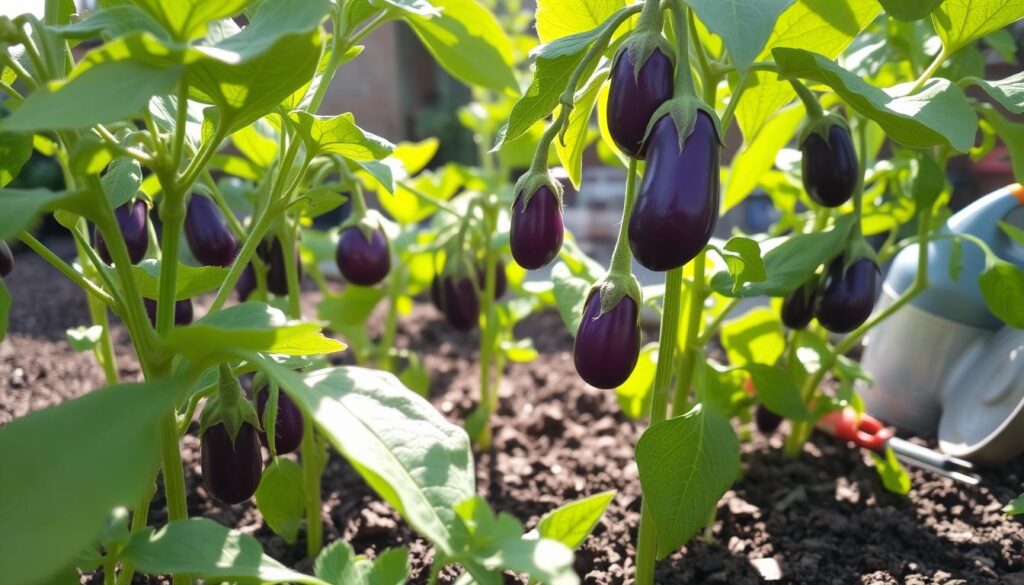
Some common problems when growing eggplants from seeds include low germination rates and weak seedlings. Pests and diseases can also be a challenge. To solve these issues, make sure the germination conditions are right. Also, use row covers or organic pest control to prevent pests and diseases. By following these Eggplant Growing Tips and taking precautions, you can grow eggplants from seeds successfully. You’ll enjoy a big harvest.
- Choose high-quality seeds suitable for your climate and desired eggplant variety
- Sow seeds in a seed tray or small pots with a good seed starting mix
- Keep soil warm and moist, and provide adequate light for germination
- Transplant seedlings into larger pots or directly into the garden, following proper spacing and care
With these Eggplant Growing Tips and a bit of practice, you’ll grow tasty and healthy eggplants from seeds.
Preparing Your Soil for Eggplant Success
To grow healthy eggplants, you need to prepare the soil right. The Best Soil for Eggplant should have the right mix of nutrients and pH. An Eggplant Planting Guide suggests a pH between 6.0 and 6.5.
Before planting, test your soil to know its pH and nutrient levels. Use the test results to add the right amendments. This will adjust the pH and provide needed nutrients.
Soil pH Requirements
Eggplants do best in slightly acidic to neutral soil, with a pH of 6.0 to 6.5. If the pH is off, it can stop the plant from getting nutrients.
Nutrient Requirements
Eggplants need a mix of nitrogen, phosphorus, and potassium. A 10-10-10 fertilizer is good for their growth.
Soil Amendment Tips
To make your soil better, add compost or well-rotted manure. These improve fertility, drainage, and nutrient levels for eggplants.
Transplanting Eggplant Seedlings Outdoors
When it’s time to move your eggplant seedlings outside, follow the right Eggplant Care Instructions. This ensures a smooth transition. Start by gradually exposing them to outdoor conditions over 7-10 days.
Begin by placing them in a shaded area outside for 2-3 hours a day. Then, increase the time and direct sunlight over a week. This helps prevent shock and boosts their growth.
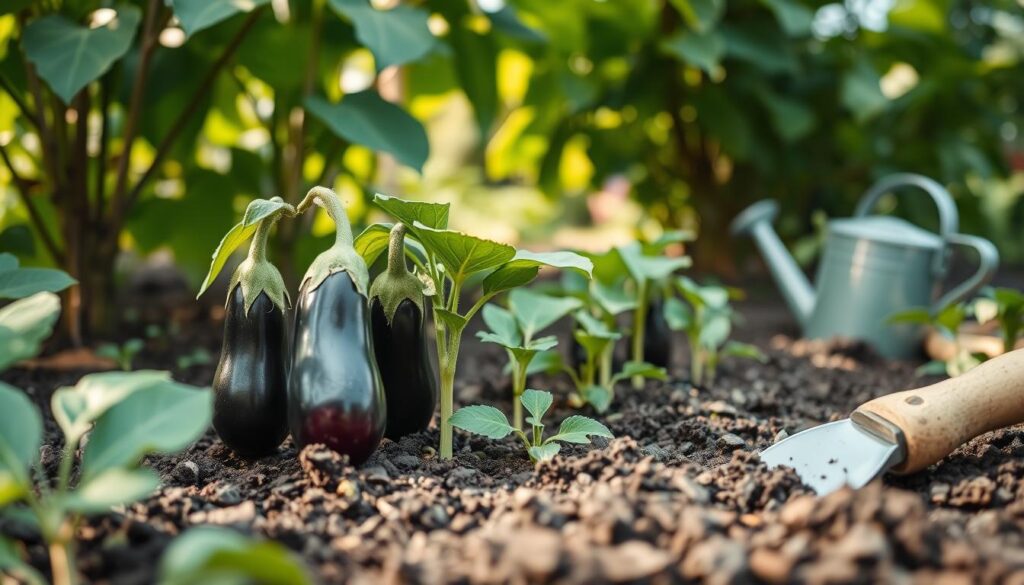
- Handle the seedlings gently to avoid damaging their roots or stems
- Plant the seedlings at the same depth as they were in their pots, and water well
- Provide support for the seedlings as they grow, using stakes or cages to keep them upright
By following these Eggplant Care Instructions and transplanting carefully, you’ll grow healthy eggplants.
Watering Requirements and Techniques
Proper watering is key for eggplant growth. It’s a vital part of Eggplant Plant Care. To give your eggplants the right water, knowing the needs and methods is important. Eggplant Growing Tips say eggplants need 1-2 inches of water weekly, from rain or irrigation.
Here are some key points to consider when watering your eggplants:
- Water your eggplants deeply and infrequently to encourage deep root growth.
- Avoid getting water on the leaves to prevent fungal diseases.
- Use a drip irrigation system or soaker hose to deliver water directly to the roots.
By following these Eggplant Growing Tips and understanding the watering needs, you can avoid water problems. Keep an eye on the soil moisture and adjust your watering schedule as needed. With the right Eggplant Plant Care, you’ll soon have a big harvest.
Here is a simple table to help you manage your eggplant watering schedule:
| Day | Watering Schedule |
|---|---|
| Monday | Water deeply in the morning |
| Wednesday | Check soil moisture and water if necessary |
| Friday | Water deeply in the morning |
Essential Fertilizing Tips for Healthy Eggplants
To help eggplants grow well, fertilizing is key. The right fertilizer boosts health and fruiting. It’s important to pick the Best Soil for Eggplant based on nutrients and pH.
Here are some important fertilizing tips for eggplants:
- Choose a balanced fertilizer with equal nitrogen, phosphorus, and potassium.
- Feed the plants when you plant them and again when they’re 6 inches tall.
- Don’t over-fertilize, as it can harm the plant and lower fruit.
By following these Eggplant Growing Tips and using the Best Soil for Eggplant, your eggplants will grow well. Always follow the fertilizer’s instructions and avoid over-fertilizing.
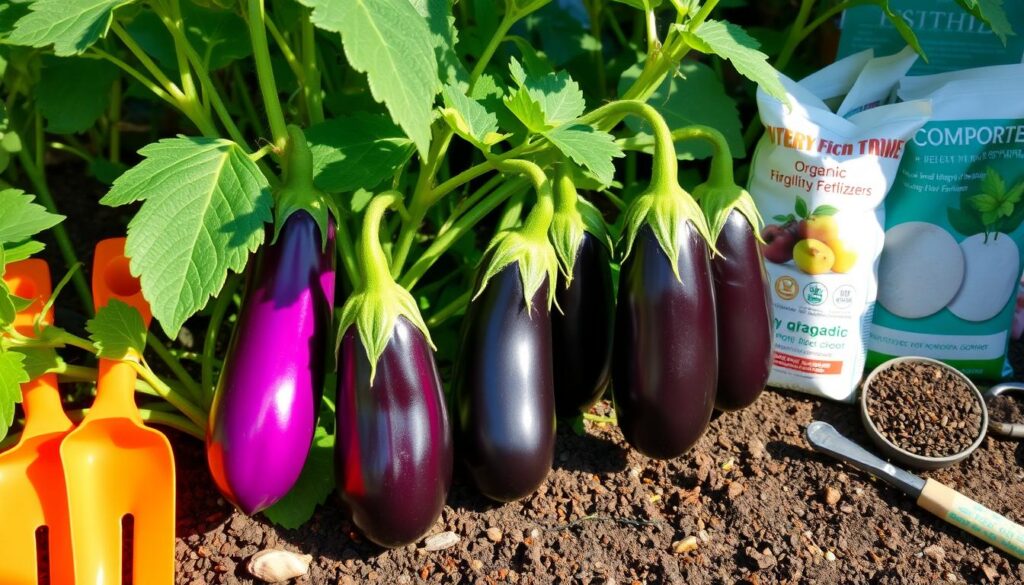
With the right care and fertilization, you’ll get a lot of tasty and healthy eggplants. Happy gardening!
| Fertilizer Type | Application Rate | Frequency |
|---|---|---|
| Balanced Fertilizer | 1-2 tablespoons per plant | Every 2-3 weeks |
| Organic Fertilizer | 2-3 tablespoons per plant | Every 3-4 weeks |
Supporting Your Growing Eggplants
Eggplants may need support as they grow. This helps prevent damage and boosts fruiting. The right support is key for Eggplant Plant Care. It keeps plants upright, increases fruit, and makes harvesting easier. This support is vital for a successful Eggplant Harvesting Tips experience.
There are several ways to support your eggplants. You can use staking or caging. Here are some options to consider:
- Staking: Use individual stakes or a trellis to support each plant, keeping them upright and promoting better fruiting.
- Caging: Place a cage around the plant, allowing it to grow and expand while providing support and protection from damage.
- Pruning: Regular pruning can help control the plant’s size, promote healthy growth, and increase fruit production.
With the right support, your eggplants will grow strong and healthy. This makes them easier to harvest and enjoy. Keep an eye on your plants and adjust your support as needed for a successful harvest.
With proper support and care, your eggplants will thrive. You’ll enjoy a bountiful harvest. Happy growing!
| Support Method | Description |
|---|---|
| Staking | Use individual stakes or a trellis to support each plant. |
| Caging | Place a cage around the plant to provide support and protection. |
| Pruning | Regular pruning to control size, promote healthy growth, and increase fruit production. |
Common Eggplant Pests and Their Control
Keeping eggplants safe from pests is key to avoid damage and boost yields. Pests like aphids, whiteflies, and spider mites can harm eggplants. To fight these, gardeners can use natural and chemical methods.
For the best Eggplant Pest Control, watch your plants closely. Act fast when you see pests. This might mean removing bad leaves, using barriers, or applying specific pesticides.
- Aphids: These small, soft-bodied insects can be controlled using neem oil or insecticidal soap.
- Whiteflies: These tiny, winged insects can be controlled using yellow sticky traps or insecticidal soap.
- Spider mites: These tiny, spider-like insects can be controlled using neem oil or insecticidal soap.
Stopping pests before they start is also vital. Use row covers to keep pests away. Keep your garden clean and avoid too much water, which pests love.
By being proactive with Eggplant Pest Control, gardeners can protect their plants. Regular checks and care can stop pests and cut down pesticide use. This makes gardening better for the environment and more sustainable.
| Pest | Control Method |
|---|---|
| Aphids | Neem oil, insecticidal soap |
| Whiteflies | Yellow sticky traps, insecticidal soap |
| Spider mites | Neem oil, insecticidal soap |
Preventing and Treating Eggplant Diseases
Eggplant diseases can harm plant health and reduce yields. To keep eggplants healthy, gardeners must prevent and treat diseases. Eggplant Disease Prevention is key for a good harvest.
Good Eggplant Plant Care helps prevent diseases. This means giving plants enough water, nutrients, and pruning. By caring for plants right, gardeners can avoid diseases and help them grow strong.
Common Disease Identification
Fungal infections, bacterial spots, and viral diseases are common in eggplants. Spotting these diseases early is vital for treatment and stopping more damage.
Organic Treatment Options
There are organic ways to treat eggplant diseases. Neem oil, copper-based fungicides, and removing sick plants are options. Crop rotation and keeping the garden clean also help prevent disease spread.
Prevention Strategies
To stop eggplant diseases, gardeners can try several methods. These include:
- Keeping plants well-ventilated
- Watering at the base to avoid leaf wetting
- Removing weeds that can carry disease
- Choosing disease-resistant eggplant varieties
By using these prevention tips and organic treatments, gardeners can keep their eggplants healthy. This way, they can enjoy a fruitful harvest.
| Disease | Symptoms | Treatment |
|---|---|---|
| Fungal Infection | Yellowing leaves, black spots | Neem oil, copper-based fungicides |
| Bacterial Spots | Small, raised spots on leaves | Remove infected plants, use copper-based bactericides |
| Viral Diseases | Yellowing or stunted plants | Remove infected plants, use resistant varieties |
Container Growing Tips for Eggplants
Choosing the right container is key for growing eggplants. They can get quite big, so pick a container that’s at least 12-14 inches deep and 2-3 feet wide. This size lets the roots grow well and supports the plant’s health. Using the best soil for eggplant is also important. It gives the plant the nutrients it needs to grow strong.
Some important things to think about for growing eggplants in containers include:
- Container size: at least 12-14 inches deep and 2-3 feet wide
- Potting mix: well-draining and rich in organic matter
- Watering: regular and consistent, but not excessive
By following these eggplant growing tips and using the right container and soil, you can enjoy a bountiful harvest of delicious eggplants, even in small spaces. 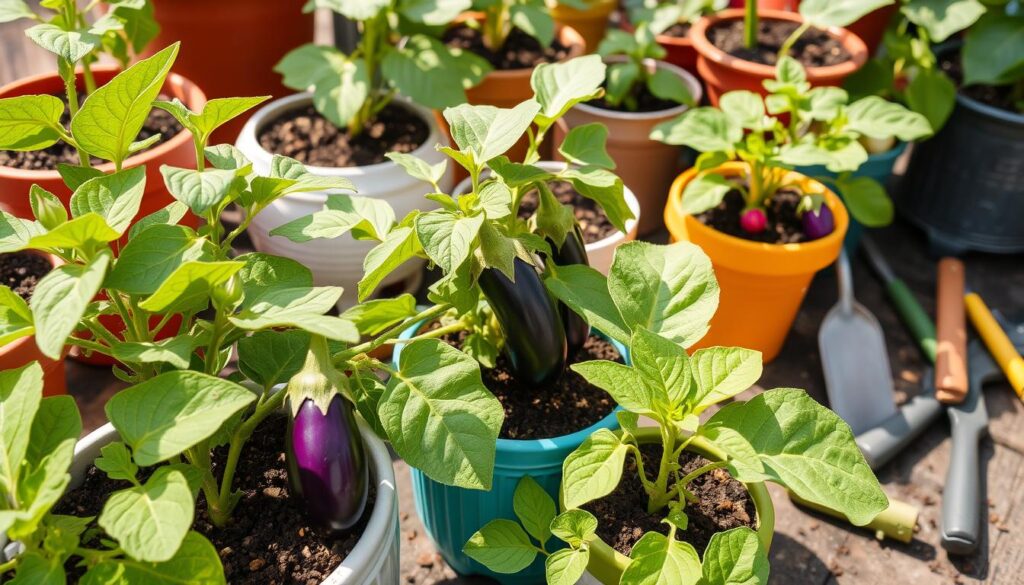
Container Care Guidelines
To keep your container-grown eggplants healthy and thriving, make sure to provide them with plenty of sunlight, water, and nutrients. Regular fertilization and pruning can also help to promote healthy growth and prevent disease.
Companion Planting with Eggplants
Companion planting is a way to grow different plants together. It helps improve growth, reduces pests, and boosts yields. For eggplants, this method is very helpful. By using an Eggplant Planting Guide, gardeners can make their garden diverse and strong.
Marigolds, basil, and beans are great companions for eggplants. They help keep pests away and attract good insects. For instance, marigolds fight nematodes that harm eggplants. Adding these plants to your Eggplant Growing Tips plan means less pesticide use and a greener garden.
Here are some perks of growing eggplants with companions:
- Improved growth and yields
- Reduced pest problems
- Increased biodiversity
By using these Eggplant Growing Tips and planting companions, gardeners can have a thriving eggplant garden. The right mix of plants and techniques leads to a rich harvest of tasty and healthy eggplants.
| Companion Plant | Benefits |
|---|---|
| Marigolds | Repels nematodes and other pests |
| Basil | Improves flavor and repels pests |
| Beans | Provides shade and improves soil health |
When and How to Harvest Eggplants
Harvesting eggplants at the right time is key for the best taste and texture. Look for a glossy sheen and a deep purple hue. The eggplant should feel firm but not hard, with a green and strong stem.
Harvest Timing Indicators
Eggplants are usually ready in 60 to 70 days after planting. Here are signs to check if they’re ready:
- A glossy appearance
- A deep purple color
- Firm, but not hard, texture
- Green and sturdy stem
Proper Harvesting Techniques
To pick eggplants, use Eggplant Harvesting Tips. Cut the stem with scissors or a sharp knife, leaving an inch of stem on the plant. Don’t pull or twist the eggplant to avoid damaging the plant and reducing future harvests.
Post-Harvest Storage Tips
After picking, store eggplants in a cool, dry spot to keep them fresh. Follow Eggplant Care Instructions. Store them in a paper bag or wrap in breathable cloth to keep humidity up and prevent moisture buildup.
Troubleshooting Common Growing Problems
When growing eggplants, you might face some common issues. By using Eggplant Growing Tips, you can lower the chance of these problems. But, if you do run into issues, it’s key to spot and fix them fast to get a good harvest.
Common problems include pest infestations, disease outbreaks, and nutrient deficiencies. To tackle these, knowing Eggplant Pest Control methods is vital. This includes organic pest control, keeping your garden clean, and making sure your eggplants get the right nutrients.
Here are some tips to tackle common growing problems:
- Keep an eye on your plants for pests or disease signs
- Choose organic pest control whenever you can
- Make sure your eggplants get all the nutrients they need
By following these tips and staying alert, you can avoid common growing problems. Always stick to Eggplant Growing Tips and Eggplant Pest Control best practices. This will help you avoid issues and get the most from your eggplant harvest.
Conclusion: Enjoying Your Homegrown Eggplant Success
Congratulations! You’ve followed a detailed guide to grow tasty and healthy eggplants in your garden. You now know how to pick the best varieties and grow them well. This will help you get a big harvest of eggplants.
Now, it’s time to enjoy your hard work. Try using your eggplants in different dishes. You can make eggplant parmesan, ratatouille, or even dips and spreads. Eggplants are very versatile, so don’t be afraid to try new recipes.
But growing eggplants is more than just the end result. It’s about the journey too. Be proud of your effort and enjoy picking your own eggplants. If you face any problems, go back to this guide or look for more help to improve your skills.
Enjoy your success with growing eggplants, and happy eating!
FAQ
What are the most popular eggplant varieties for home gardens?
Home gardeners often choose Black Beauty, Ichiban, Fairy Tale, and Rosa Bianca eggplants. These varieties come in different shapes, sizes, and colors. They fit various tastes and growing conditions.
What are the ideal climate and temperature requirements for growing eggplants?
Eggplants love warm, sunny spots with temperatures between 70°F and 85°F. They need well-drained soil and can handle some heat. But too much heat or cold can harm their growth.
What is the best soil for growing eggplants?
Eggplants do best in soil that drains well and is rich in nutrients. The soil should be slightly acidic, between 6.0 and 6.8 pH. Adding compost or organic matter helps with nutrients and drainage.
How much sunlight do eggplants require?
Eggplants need lots of sunlight, at least 6 to 8 hours a day. Choose a spot that gets plenty of sun for their growth and fruit production.
How do I grow eggplants from seeds?
Start eggplant seeds indoors 6-8 weeks before the last frost. Use seed trays or containers, keep them moist, and give them lots of sunlight. Once they’re 6-8 inches tall, harden them off and move them outside.
How do I transplant eggplant seedlings outdoors?
Before moving seedlings outside, harden them off for 7-10 days. Plant them in well-draining soil, 18-24 inches apart. Water them well after transplanting to help them adjust.
How often should I water my eggplants?
Eggplants need consistent moisture, more so in summer. Water them 1-2 inches per week, adjusting based on weather and soil. Avoid too much water to prevent root rot.
What type of fertilizer should I use for my eggplants?
Use a balanced, slow-release fertilizer like 10-10-10 or 5-10-5. Follow the manufacturer’s instructions, usually at planting and every 4-6 weeks during the growing season.
How do I support my growing eggplants?
Support your eggplants to prevent fruit damage. Use staking, caging, or trellising. Prune the plants to improve air circulation and fruit production.
What are common eggplant pests and how do I control them?
Common pests include aphids, spider mites, and eggplant flea beetles. Use beneficial insects, organic insecticidal soaps, or row covers to control them.
How do I prevent and treat eggplant diseases?
Diseases like verticillium wilt and powdery mildew can affect eggplants. Practice good sanitation, use resistant varieties, and apply organic fungicides or bactericides as needed.
Can I grow eggplants in containers?
Yes, eggplants can thrive in containers. Use a large pot (at least 5 gallons) and a well-draining mix. Ensure plenty of sunlight and consistent moisture, and consider support structures.
What are some good companion plants for eggplants?
Marigolds, basil, and tomatoes are great companions for eggplants. They help deter pests, improve soil health, and create a diverse garden ecosystem.
How do I know when to harvest my eggplants?
Eggplants are ready when they’re 4-8 inches long and firm. The skin should be shiny and without blemishes. Twist and pull the fruit gently, leaving a short stem.
What are some common growing problems with eggplants, and how can I troubleshoot them?
Problems like stunted growth and blossom end rot can occur. Check soil conditions, water, and nutrients. Monitor for pests and diseases. Use prevention and treatment strategies to overcome these issues.
Share this post: on Twitter on Facebook

